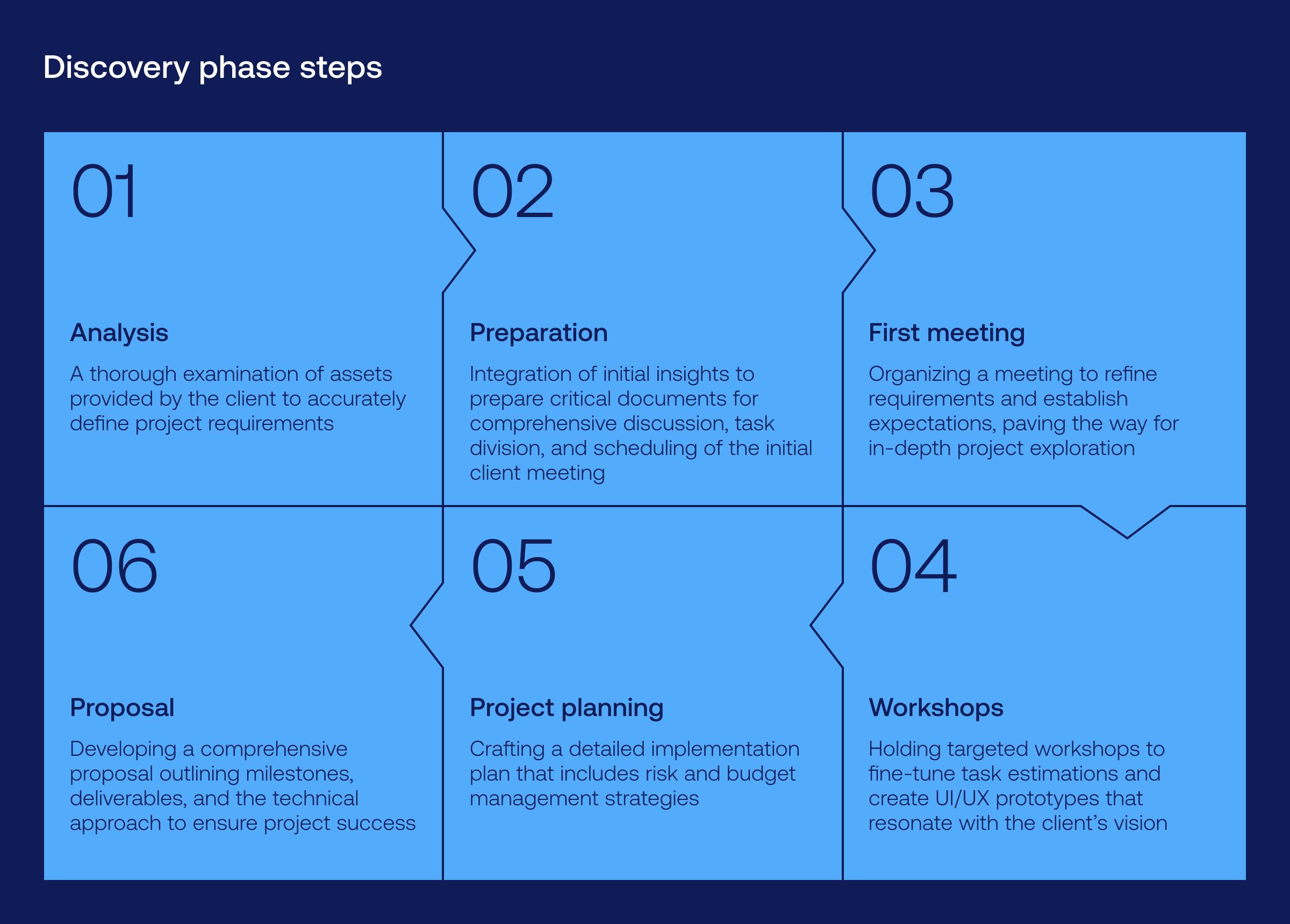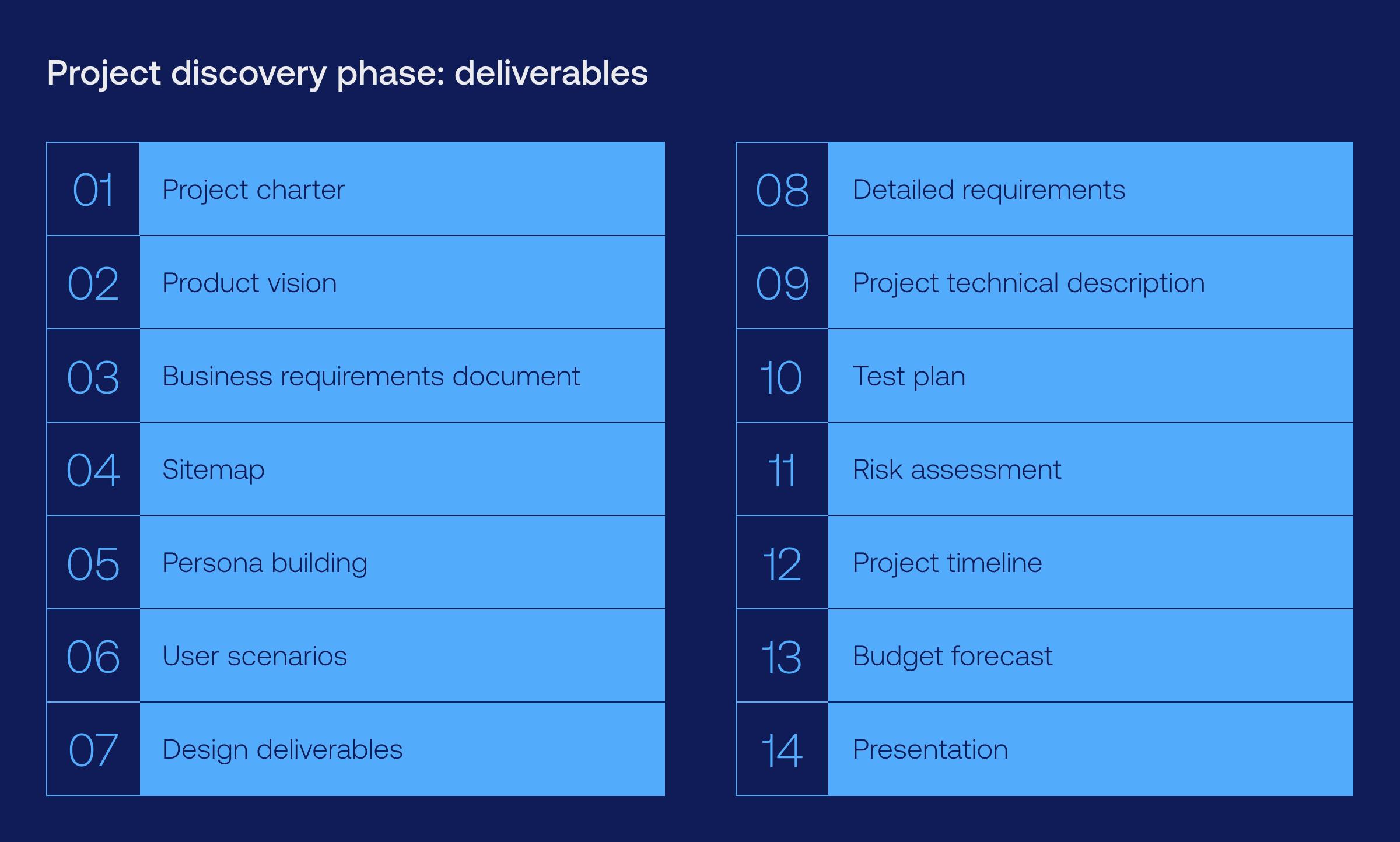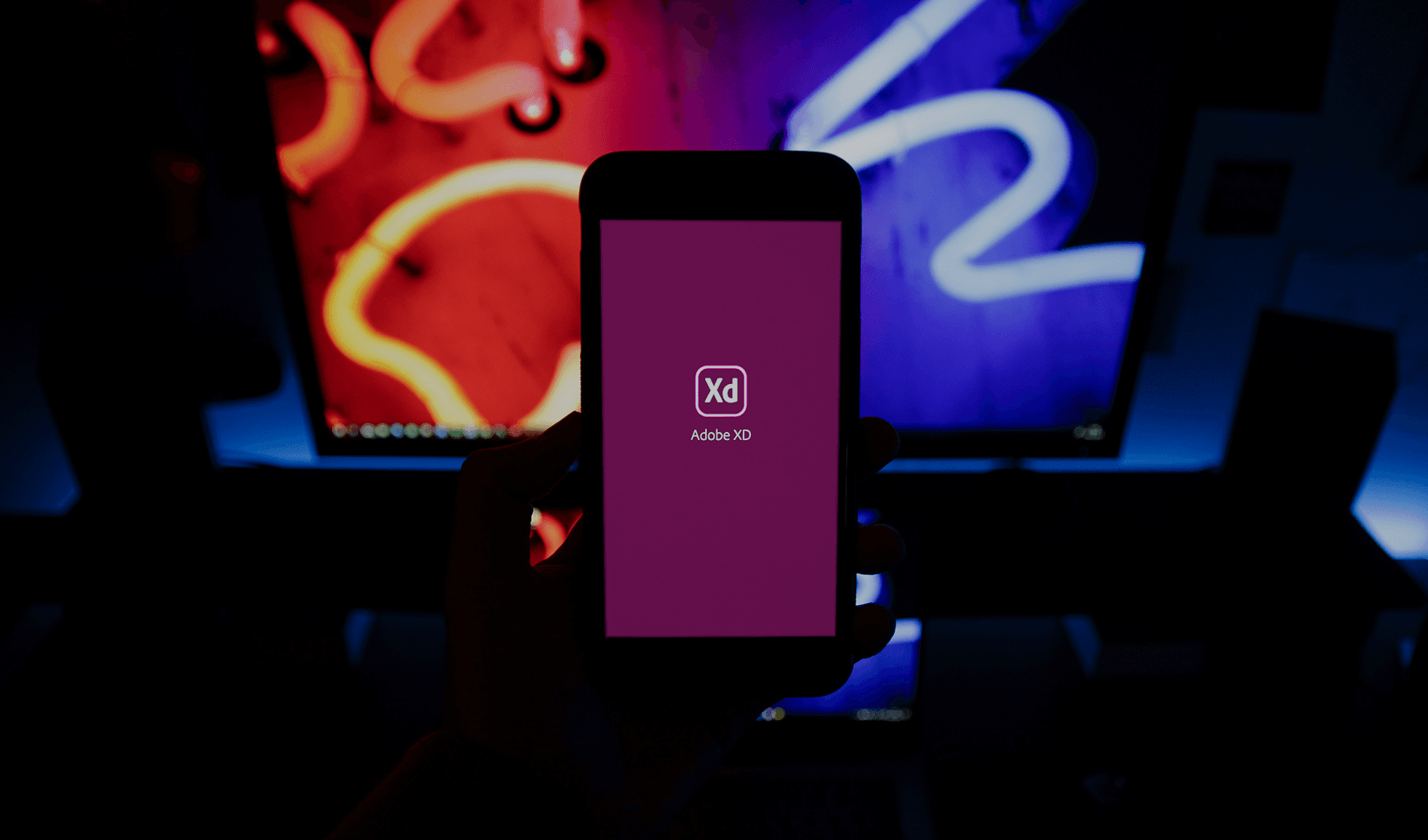
Project discovery phase: Well begun is well done

Venturing into the next software development undertaking, project initiators hope for the best. Yet, “the best” is not always the case. Actually, it’s not even close to always.
According to Deloitte, one in five projects fail to deploy, and nearly half either overrun their budgets or miss deadlines. The root cause of these failures usually traces back to insufficient planning. The solution? A robust discovery phase.
With a solid track record of 20+ years in software development consulting, we're fully equipped to set your project up for success. This guide distills our extensive experience with 500+ clients into essential strategies and insights.
What is a discovery phase in software development?
To get real value out of their shiny new products, companies need much more than just tech – they need a strategy. The discovery phase is the initial step in the lifecycle of a software project that involves clarifying ambiguities, identifying potential obstacles, and developing a strategic plan.
The discovery stage aims to assess the idea's viability and ensure that investments are wisely made, all while gathering and analyzing project requirements. This helps develop a detailed delivery plan with accurate time and cost estimates. Typically spanning from one to three months, the duration of the discovery phase varies based on the project's complexity.
Project discovery becomes essential in the following scenarios:
- The client company has a stringent budgeting policy, and all expenses are planned well in advance.
- The project's vision is vague, and its requirements are unclear.
- The project is technically complex and requires a thorough examination of what can or can’t be done.
- There is a lack of existing documentation, and/or the information is dispersed across various stakeholders.
In such cases, jumping straight into development is justifiable only for repeatable projects with a standardized, well-defined set of requirements or minor updates to the existing software.
The discovery phase of a software project lays a solid foundation by addressing critical questions:
-
Is it technically and economically viable to proceed with the project?
-
What are the main objectives the project has to achieve?
-
What is the vision for the product, and how does it support business objectives?
-
What are the specific business and technical requirements for the project?
-
What are the characteristics, needs, and behaviors of the target users?
-
What technologies and frameworks will be used during development?
-
What is the project timeline with milestones, deadlines, and key deliverables?
-
What are potential risks or challenges related to the project, and what strategies do you need to address them?
-
What is the estimated budget required for the project?
-
What roles do you need on your software development team?

Why does the software product discovery phase matter?
Against a challenging economic backdrop, where executives are expected to do more with less and show results immediately, the discovery phase seems excessive. But is it?
Main risks of skipping the software project discovery phase
Speed can often create only an illusion of efficiency, potentially causing a myriad of issues:
-
Unviable solution: Without validating the idea's viability, a company might invest in a system that turns out to be technically or financially unfeasible.
-
Scope creep: Unclear project scopes can lead to continuous additions or changes without proper evaluation, resulting in projects that exceed budget and timeline.
-
Mismatch with stakeholder expectations: Without clear alignment on project objectives, the result may not meet stakeholder needs, potentially requiring costly adjustments post-launch.
-
Poor resource allocation, timelines, and budget estimates: The lack of proper planning can cause inefficient resource utilization, unrealistic timelines, and increased expenses.
-
Insufficient expertise: Not assessing technical demands early and securing necessary expertise can lead to setbacks and inferior quality products.
-
Integration challenges: Not considering the current technology landscape may result in integration difficulties with existing systems, limiting your product usability and efficacy.
-
Security vulnerabilities: Overlooking security considerations at the outset can expose projects to risks that jeopardize data and system integrity.
-
Quality issues: Not putting a premium on quality assurance planning comes at a price of bug-ridden software, which is detrimental to the company’s budget and, in the worst-case scenario, reputation.
-
Misalignment with broader business goals: Projects that don’t align with the organization's overarching objectives fail to provide true value.
-
Increased project costs: Software projects often see costs going up due to changes made later in the development lifecycle, though they could have been prevented with upfront analysis during the discovery phase.
-
Delayed timelines: Unforeseen challenges almost always mean pushbacks of the launch date.
What benefits does the project discovery phase bring to the table?
At Vention, we’ve honed the discovery project service for over two decades, making it a cornerstone of our expertise. Below are the essential benefits that have influenced our clients to prioritize meticulous project planning.
-
Risk reduction
With the groundwork laid during the discovery phase, projects are better equipped to identify and fend off risks early on — be it poor requirements (leading to the project failure in 39 percent of cases), expertise-related issues (30 percent of cases), or misalignment in stakeholders’ perspectives (57 percent of cases).
The main goal of the discovery phase is not to allow you to be caught off guard by potential pitfalls, significantly reducing the likelihood of project derailments.
-
Stakeholder engagement and buy-in
An often-undervalued benefit of the discovery phase is how it helps align stakeholders, thereby building trust in the project's direction. By engaging stakeholders early and enhancing communication, the discovery process ensures everyone is aligned and addresses concerns proactively.
-
On-time and on-budget delivery
Only 16.2 percent of projects are completed on time and within budget. Aiming to make it to the success cluster, one of Vention’s clients, Sperry Rail, decided to put their legacy software modernization project on the rails right from the start and kick off with a software product discovery phase.
As a result, the client got a series of deliverables, including but not limited to a detailed project roadmap and accurate long-term budget forecasting. After moving forward with Vention to the development and delivery stages, the client stated it was the first time they’d seen a complex software project finished under budget and on schedule.
-
Efficient change control
The discovery phase is also instrumental in establishing a robust change management system, which is vital for handling scope and budget creep—two prevalent issues that can jeopardize project outcomes. By setting clear parameters and expectations upfront, the discovery phase provides a framework for assessing, managing, and integrating changes more efficiently.
This well-thought-out, phased approach became game-changing for another Vention’s client, VerseX Studios, a game developer. We started working with the client by helping them define their game development strategy, focusing on the product’s community aspect, its users, and what makes it stand out.
After creating a comprehensive project plan, designs, and evaluating risks and competitors, we advised on optimal technologies — from game engines to programming languages. Plus, instead of a full-scale launch, we recommended a phased approach: starting with a basic version and progressively adding features to maintain player interest over time.
Vention’s example of how the discovery phase helps control project costs
Every project we undertake confirms that the discovery phase is a pivotal, not just preliminary, point in a software development project, determining how big your gains will be in the end. Vention’s recent partnership with a service provider catering to the US and European markets showcased this principle in action.
At first, our discovery phase services involved analyzing the existing product and sorting features into three categories: high-priority (frequently used), low-priority (rarely used), and redundant (never used). Armed with this real-world data, we pinpointed where to add more value.
By focusing on what truly matters to end-users in the MVP and setting the stage for future enhancements, we streamlined or eliminated less critical functions for later versions. Choosing to leave out low-priority features initially and optimize them later on allowed us to make the most of the available resources and steer clear of redevelopment costs. That way, the discovery phase saved the client time and ensured each dollar spent directly contributed to enhancing user satisfaction and engagement.
Discovery phase steps

The discovery process can be boiled down to a set of methodical steps.
Analysis
The journey kicks off when the client shares available project assets — ranging from a basic concept to requirements specification or even mockups. In response, the unit manager, a project manager, and a solution architect carefully examine every detail to ensure they fully grasp the client’s needs and expectations.
Preparation
Armed with the insights from the initial analysis, the project team prepares for the discovery workshop. This involves several concurrent tasks.
-
Question preparation
A key task here is creating a shared document that acts as a hub for questions and topics for discussion, welcoming input from all team members. This ensures a thorough exploration of the project scope.
-
Task decomposition and estimate
Meanwhile, another document is compiled for the initial breakdown and timeframe estimate of tasks. Any questions arising during this stage are addressed in meetings with the client.
-
Planning the meeting
Equipped with a list of questions and a solid understanding of the project’s elements, the team arranges the first meeting with the client and sends them an agenda based on the topics prepared.
The first meeting
The first meeting provides an opportunity to ask questions and outline the schedule for discovery workshops, where the team delves deeper into the client's business to specify requirements and foster mutual understanding.
Workshops
Following the call, the team holds a series of project discovery workshops (PDWs), where the task decomposition and estimations are refined, with newfound insights integrated into project planning. This phase also involves the development of UI/UX prototypes and API specifications to accurately capture the client's vision.
Project planning
After understanding the project scope, experts work on crafting a plan. This involves outlining the implementation process step by step, from setup to testing and demonstrations.
Besides time estimation, the team takes care of the risk management strategy and budget plan, helping to set realistic expectations of what lies ahead.
Proposal
The discovery phase of a software development project concludes with presenting a proposal that encapsulates the project's essence. This document offers a comprehensive overview of milestones, deliverables, deadlines, budget forecasts, tech stack recommendations, solution architecture, and the next steps — setting the stage for successful project outcomes.
Want to ensure your project reaches completion successfully?
We’ll resolve uncertainties in the discovery stage.
Discovery phase of a software project: Who is on board?
A seasoned cross-functional team is an essential element of the discovery success formula. In its expanded version, the discovery team could feature the following key players:
|
Project manager (PM) |
If we had to distill the essence of a project manager into just one word, it would be a "coordinator." The PM takes the reins and ensures that every part of the process contributes to the end goal.
|
|
Business analyst (BA) |
A business analyst might play second fiddle to the PM and, yet, that is the team member who bridges the gap between the client’s idea and a real solution.
|
|
Designer (optional) |
Designers make ideas more palpable for the client by providing blueprints for a future product.
|
|
Quality assurance |
If you aim for the highest quality standards for your product, involving a QA engineer from the onset is a wise choice. This proactive step not only enhances your product's quality, but also accelerates the development process by addressing issues early rather than retroactively.
|
|
Security (optional) |
For projects in highly regulated sectors (say, healthcare or fintech), incorporating a security expert from the beginning is essential to ensure the foundational security of the solution.
|
|
Development team |
Developers provide input regarding technical capabilities and limitations of the future system.
|
The product discovery toolkit
With the right tools in place, discovery teams can stimulate collaboration, collect and sift through ideas more quickly, and deliver the first tangible results in wireframes or prototypes in weeks — providing a solid basis for further decision-making.
|
Project planning and scheduling |
|
|
Project management |
|
|
Documentation |
|
|
Wireframing and prototyping |
|
|
Requirements management |
|
|
Development |
|
|
Diagramming |
|
|
Communication and video conferencing |
|
|
Survey and feedback |
|
|
Mind mapping |
|
Project discovery phase deliverables

The result of the activities during the discovery phase is distilled into a suite of clear, actionable deliverables provided in a particular order — each serving as input for the next step.
|
Main deliverables |
Short description |
Involved players |
|
Project charter |
Creates a shared understanding of the project objectives and requirements. |
PM/BA |
|
Product vision |
Indicates the long-term mission of your product and maps out its future direction, serving as a guide for all stakeholders involved. |
PM/BA |
|
Business requirements document |
Details the project's vision, main goals, scope, stakeholders, crucial requirements, expected outputs, system specifications, constraints with a cost-benefit analysis, quality standards, and an exhaustive timeline. It ensures the project is in sync with corporate objectives and lays out a comprehensive path from start to finish. |
PM/BA |
|
Sitemap |
Acts as an architectural blueprint for your website or app, structuring pages in an understandable hierarchy, which aids both designers and developers in crafting an intuitive user interface. |
PM/BA |
|
Persona building |
Creates fictional user profiles to represent the characteristics and needs of the target audience, helping businesses address specific challenges of specific groups of people in specific situations. |
PM/BA |
|
User scenarios |
Describe how a user interacts with a product, which informs design and development choices and spotlights new business opportunities. |
PM/BA |
|
Design deliverables |
Wireframes — basic visual representations of the user interface centered on distributing and prioritizing content, functionalities, and expected interactions. UI screens — detailed visual designs of user interface elements, ensuring a cohesive and attractive look. Interactive prototype — a clickable model of a future product, simulating the experience of the final build. |
Design team |
|
Detailed requirements |
Elaborates on business requirements, detailing them further based on insights from previous discovery phase activities. |
PM |
|
Project technical description |
Captures the technical specifications of the project, including architecture, frameworks, and technologies utilized. |
Project manager |
|
Test plan |
Outlines strategies for quality assurance, specifying test cases, procedures, and criteria for success. |
QA / Security / BA / PM |
|
Risk assessment |
Identifies potential project risks and proposes mitigation strategies to minimize negative impacts. |
QA / Security / BA / PM |
|
Project timeline |
Decomposes the entire project into smaller, manageable tasks and milestones, assigning a deadline for focused progression. |
PM |
|
Budget forecast |
Calculates the financial needs, covering resources, tools, and development process costs. |
PM |
|
Presentation |
Concludes the discovery phase of a project by providing stakeholders with a summary of what has already been done and what is planned ahead. |
PM/BA |
Vention’s approach to setting your project on the right track
At Vention, we view the discovery phase as a critical first step that, in many ways, decides the future of the product. Our approach ensures no do-overs are necessary, enabling you to get it right from the start.
Our vetted experts draw on tried-and-true practices to explore ideas, map out possibilities, and shape the path toward a resilient solution.
-
Deep diving into details. We examine every project aspect to ensure the final solution is perfectly tailored to the client’s needs and expectations.
-
Cross-functional team engagement. Discovery is a team sport. We assemble cross-functional teams—business analysts, project managers, developers, designers, and QA engineers— to ensure no detail is overlooked.
-
Granular approach. We facilitate focused and efficient work streams by dividing the project into distinct phases. The result? On-time delivery and predictable outcomes.
-
Recognizing task dependencies. Our discovery team skillfully maps out task dependencies to avoid complications and ensure smooth progression.
-
Strategic planning. With detailed schedules designed to manage team performance and take scope creep under control, we stay on track toward the project completion while remaining adaptable to any changes or obstacles that spring up down the road.
“Jumping directly into development can often lead to overlooking the bigger picture, resulting in wasted resources or misguided efforts. The first step should always be to validate the business concept for viability. Following that, we establish a clear project scope with thorough planning and prototyping.
Essentially, the discovery phase injects clarity and precision into even the most complex projects, bridging the gap between client expectations and practical feasibility of the solution.”
Don't let your project miss its mark.
Make most of our discovery phase service for software development.





